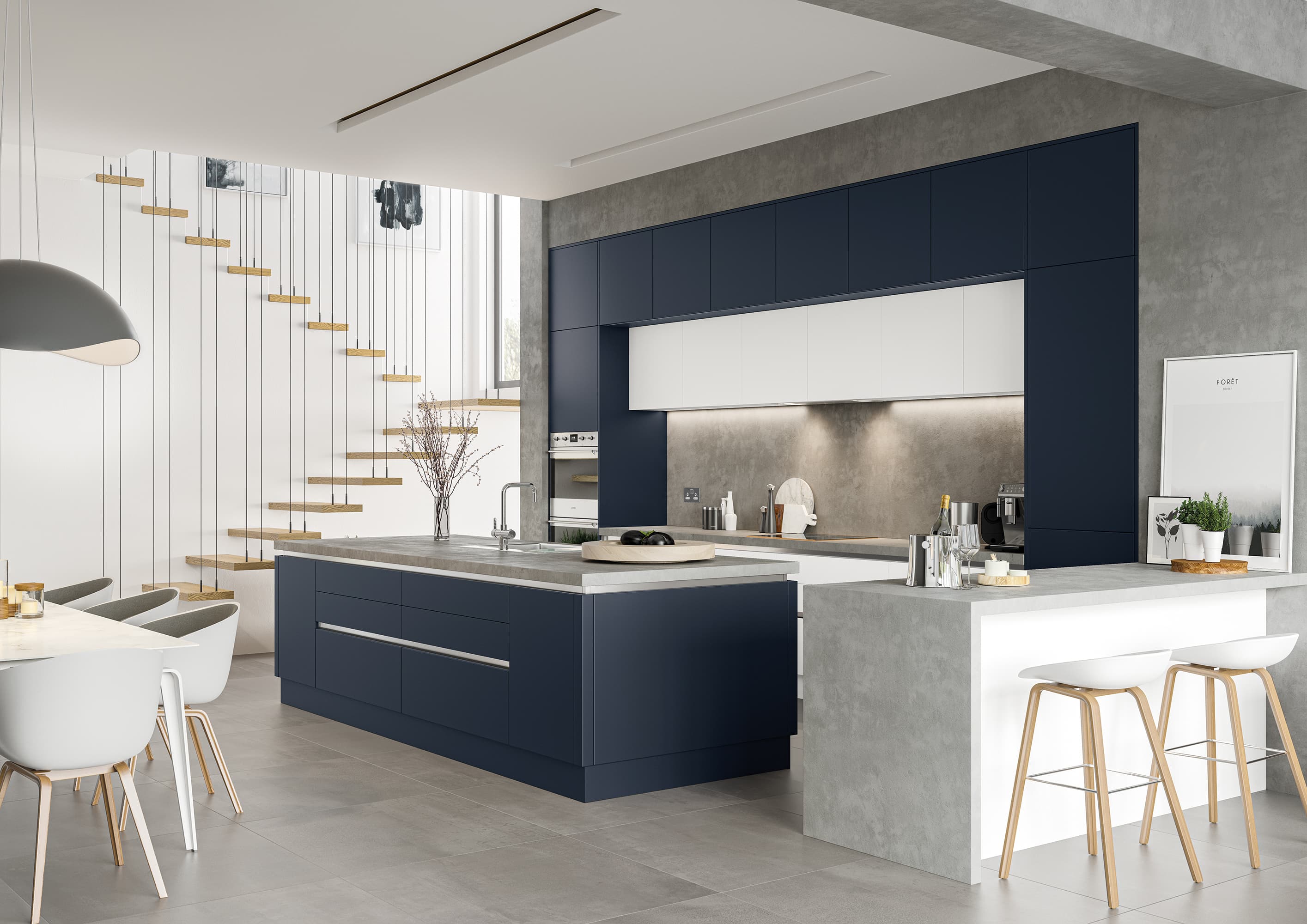How to choose the right Handleless Kitchen
How to choose the right Handleless kitchen
Handleless Kitchens are now one of the most popular types of kitchen style. Many of our customers initially come to us stating they want a handleless kitchen but which type? Not all handleless kitchens are created equal and so this article will outline the two main types of handleless kitchen and the door finishes available. Hopefully, this will aid in your decision when considering handleless as an option for your new kitchen design.
Handleless Kitchen Types;
True Handleless, also known as Handleless Rail System
J Pull or handleless door
True handleless, or handleless rail kitchens, involve the installation of a recessed rail, normally metallic, to be installed into the cabinets. The cabinets therefore have to be routered (cut out) in advance to accept this rail and by doing so this allows a recess for the hand to be able to open the kitchen.
This diagram, curtesy of our partners at Second Nature Kitchens, gives a clear picture of what is required.

Some examples of true handleless kitchens can be seen below;

Handleless rail kitchens are generally more expensive as there is the additional work in routering of the cabinets and also the additional cost of the rail profiles (lengths), end caps and other finishing items for the rail. It is considered a premium product.
Due to the cost and complexity of true handleless, the J Pull Kitchen, or handleless effect kitchen has become extremely popular. The J Pull simply means that the handle is cut into the door, thus allowing you to open the door or drawer. This alternative requires no routering to units and no additional cost of the rail system thus meaning a quick, simple and cost effective solution in giving a handleless kitchen effect.
The below is an example of a J Pull Kitchen Door; our Remo Kitchen Range.

Some examples of J Pull Handleless kitchens or Handleless effect kitchens are below;


Once you have decided on whether to go for a J Pull or rail system kitchen you then need to decide what type of door material and finish to choose.
Door Finish Types:
Vinyl Wrapped / Foil / PVC / PET Doors
Lacquered / Painted Doors
Acrylic Doors
Veneered or Timber Doors
1. Vinyl Wrapped / Foil / PVC / PET Doors
Wrapped doors are normally the cheapest kitchen door option. Wrapped doors are generally a chipboard or MDF core with a vinyl wrapped covering. Finishes tend to come in both matt and gloss. Although wrapped products have certainly improved, they lack a quality finish and suffer from de-lamination; especially where you have heat and water. They are generally the cheapest offering and mainly used by the national retailers.
2. Lacquered / Painted Doors
Lacquered doors, which are available for both true handleless and J Pull style kitchens offer an MDF core that is primed and painted. Most doors will offer a minimum two coats but some more premium doors will offer three for a slightly better finish. They tend to come in thicknesses of 18mm to 22mm depending on the quality. They are normally available in matt or gloss finishes. Lacquered doors don’t suffer from de-lamination like wrapped doors do so they generally are considered a more premium product; you’ll normally pay slightly more for lacquered doors over wrapped. One other disadvantage is that lacquered or painted doors can chip as they are of course painted. In my experience,however, most good quality painted doors are fairly resistant and touch up kits are available to repair minor chips or scratches.
3. Acrylic Doors
Acrylic doors have become increasingly popular over the past few years; mainly due to their versatile nature, they tend to come in bespoke sizing options, and their hard wearing properties. Acrylic doors come in standard colour option (with matching edging finish) or with a two tone effect edging for a different edging colour finish and with matt, gloss or metalic finishes. Our unity range is an example of a made to measure acrylic door; giving complete flexibility about the size of each cabinet door and drawer whilst remaining extremely long lasting. The only negative is they tend to be slightly more expensive than lacquered doors.
4. Veneered or Timber Doors
Veneered or solid timber doors come in all shapes and sizes; but more relevant to this article on handleless doors are veneered doors. The are generally MDF or chipboard cores with 0.8mm or similar veneered finish. Veneered finishes tend to give a big impact to the visual of the kitchen; some offer textured finishes as well as gloss and matt finishes, such as the Burnt Ash door in our Alpina range. They are generally fairly expensive due to the cost of manufacture but offer something a bit more unique.
I hope you found this guide informative in helping you decide on your next handleless kitchen and if you’re like more information on our kitchen ranges or some advice on planning your new kitchen please get in touch with one of our friendly design team.
